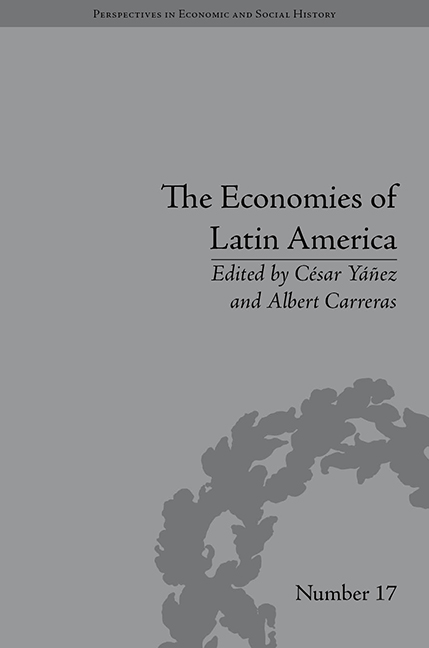Book contents
- Frontmatter
- CONTENTS
- List of Figures and Tables
- List of Contributors
- Preface
- Introduction: Latin American Economic Backwardness Revisited
- 1 Expectations, Institutions and Economic Performance: Latin America and the Western European Periphery during the Twentieth Century
- 2 On the Accuracy of Latin American Trade Statistics: A Non-Parametric Test for 1925
- 3 Latin America and Its Main Trade Partners, 1860–1930: Did the First World War Affect Geographical Patterns?
- 4 The Structure of Latin American Investment in Equipment Goods during the Mature Period of the First Globalization
- 5 Factorial Distribution of Income in Latin America, 1950–2000: New Series from the National Account Data
- 6 The Influence of the First World War on the Economies of Central America, 1900–29: An Analysis From a Foreign Trade Perspective
- 7 Economic Modernization in Adverse Institutional Environments: The Cases of Cuba and Chile
- 8 Capital Goods Imports, Machinery Investment and Economic Development in the Long Run: The Case of Chile
- 9 The Sugar Industry, the Forests and the Cuban Energy Transition, from the Eighteenth Century to the Mid-Twentieth Century
- 10 Empirical Debate on Terms Of Trade and the Double Factorial Terms of Trade of Colombia, 1975–2006
- 11 Public Revenues in Bolivia, 1900–31
- 12 The Consumption of Durable Goods in Latin America, 1890–1913: Analysis and Estimation of a Demand Function
- Notes
- Index
8 - Capital Goods Imports, Machinery Investment and Economic Development in the Long Run: The Case of Chile
- Frontmatter
- CONTENTS
- List of Figures and Tables
- List of Contributors
- Preface
- Introduction: Latin American Economic Backwardness Revisited
- 1 Expectations, Institutions and Economic Performance: Latin America and the Western European Periphery during the Twentieth Century
- 2 On the Accuracy of Latin American Trade Statistics: A Non-Parametric Test for 1925
- 3 Latin America and Its Main Trade Partners, 1860–1930: Did the First World War Affect Geographical Patterns?
- 4 The Structure of Latin American Investment in Equipment Goods during the Mature Period of the First Globalization
- 5 Factorial Distribution of Income in Latin America, 1950–2000: New Series from the National Account Data
- 6 The Influence of the First World War on the Economies of Central America, 1900–29: An Analysis From a Foreign Trade Perspective
- 7 Economic Modernization in Adverse Institutional Environments: The Cases of Cuba and Chile
- 8 Capital Goods Imports, Machinery Investment and Economic Development in the Long Run: The Case of Chile
- 9 The Sugar Industry, the Forests and the Cuban Energy Transition, from the Eighteenth Century to the Mid-Twentieth Century
- 10 Empirical Debate on Terms Of Trade and the Double Factorial Terms of Trade of Colombia, 1975–2006
- 11 Public Revenues in Bolivia, 1900–31
- 12 The Consumption of Durable Goods in Latin America, 1890–1913: Analysis and Estimation of a Demand Function
- Notes
- Index
Summary
Introduction
Studies about machinery equipment investment have a long tradition in economics and economic history. Since the analysis of the Industrial Revolution and the growth studies of the twentieth century, there are indications that economic growth of countries has a strong nexus with investment in capital formation and specifically, with the machinery equipment investment. However, in the case of developing countries there is a lack of quantitative studies in the long run about the relationship between growth and machinery equipment investment.
This study about machinery investment and growth addresses three critical elements. First, most studies are for a short period of time, twenty-five years or less. Second, the majority of papers present correlations with a great number of countries without a comparison of the kind of investment. A growth process based on capital formation in construction (dwellings and non-residential structures) differs from growth based on machinery investment. More specific, there is another relevant disaggregation: non electrical machinery, electrical machinery and transport equipment that should be take into consideration.
Third, a developing country, Chile was elected to study its relationship with machinery imports in the long run, in an attempt to give to the debate about capital formation and growth another vision.
The article is organized as follows: in section 2, theory and empirics of growth and capital (machinery equipment) investment is presented; section 3 shows the methodology of the data base of machinery imports in Chile; section 4 presents the econometric model to fit the data with the theoretical approach; section 5 the results of causality tests and section 6 concludes.
- Type
- Chapter
- Information
- The Economies of Latin AmericaNew Cliometric Data, pp. 119 - 130Publisher: Pickering & ChattoFirst published in: 2014

